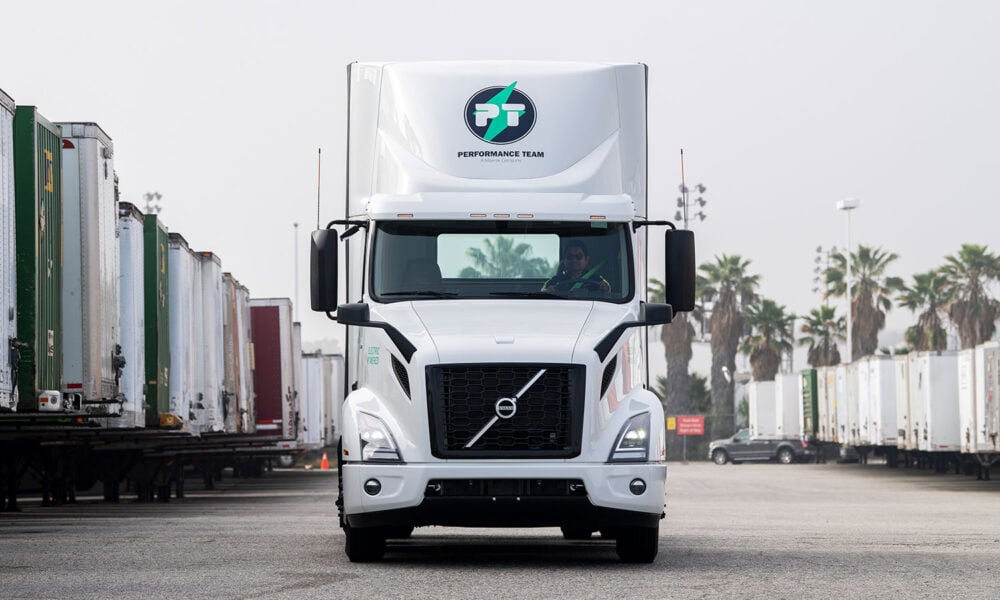The transition to replace the most heavily polluting diesel vehicles on the road with zero-emission models is critical both to avoid the worst effects of climate change and to clean up foul air in freight-adjacent neighborhoods. Indeed, the communities most impacted by local air pollution from freight have been leading the call for the zero-emission freight for decades—you should hear from our partners at the Moving Forward Network (MFN) directly on this (see here and here for starters). Together, we advocate for policies to achieve 100 percent zero emission truck sales by 2035.
I wrote previously about the general categories of where zero-emission electric trucks charge—home base and, for some, public and shared private chargers. We got a more solid vision of the geographic locations where trucks do and will need to charge last week when the Biden-Harris administration released the National Zero-Emission (ZE) Freight Corridor Strategy. The strategy is yet another piece of the federal electric vehicle vision coming to fruition.
That strategy is a multi-agency effort involving the Department of Energy, the Department of Transportation, the Environmental Protection Agency (EPA), and the Joint Office of Energy and Transportation (Joint Office); and it quite literally maps out where charging and fueling should be installed over time to support the transition to 100 percent zero-emission truck sales.
The major sea and dry ports, logistics hubs, and trucking routes highlighted in the strategy are not a total surprise, certainly not to the communities who live along those fence lines, and also not to those who have been watching the freight electrification space closely. For one thing, the strategy is highly reminiscent of recent work done by entities such as the International Council on Clean Transportation and CALSTART with its phased approach that starts with hubs and builds out from there. It’s good to see various assessments converging in this way. What is novel is that the federal government has undertaken this strategy, and in doing so, the strategy can directly affect decisions being made at the agencies on setting vehicle standards and awarding grant funding. As a federal initiative, it also provides a strong signal to private sector actors as well as state and local governments who have a role in advancing the transition to zero-emission freight.
Thus, the commitment to advancing the transition to zero-emission freight that the Biden-Harris administration shows in this strategy is significant. To better understand that significance let’s break down what the strategy does and does not do.
What does the strategy do?
The National ZE Freight Strategy recognizes that not all of the charging and fueling infrastructure that we will eventually need has to be built up-front in order for the transition to work. Rather, the build-out can and should begin in areas where near term adoption makes the most sense and is most likely, and then move on to subsequent areas as additional zero-emission freight use cases become more and more practical. Identifying this phased approach allows all relevant actors—the federal agencies, state and local governments, and private sector actors—to focus time and resources in an intentional and coordinated way over specific periods of time.
That intentional coordination on commonly identified locations over time is particularly important for the build out of electric grid infrastructure that must happen alongside, or preceding, the build-out of customer-side infrastructure to support electric freight truck charging. The national strategy provides a strong direction and additional data points for electric utilities to use in proactively planning grid upgrades and in making the case for those upgrades in the utility regulatory process.
In addition, the strategy shows how charging and fueling infrastructure could be deployed to support successful compliance with the strongest possible rule on greenhouse gas emissions from trucks. Such a rule is under consideration currently at EPA, and it is expected to be finalized within weeks. Taken together, the freight corridor strategy and a strong greenhouse gas rule have the potential to create much more momentum for the zero-emission transition than either one alone.
What doesn’t the strategy do?
It’s worth noting that the strategy doesn’t have many teeth, at least not by itself. According to the strategy, the lists of ports, hubs, and corridors in the document will be prioritized by agencies to award funding in grant programs (e.g., the Clean Ports Program and the Charging and Fueling Grant Program). But the strategy does not have funding attached to it directly. The strategy will serve as a signal to subnational governments and private actors (including utilities) who have a large role in implementing the strategy and the transition to zero-emission freight more broadly. But it can’t compel those necessary actors to do anything. What is more, a future administration could come along and shelve the strategy, either by refusing to uphold and pursue the strategy or by explicitly denouncing it. Were the strategy to be shelved, it wouldn’t obviate the shift from dirty to zero-emission freight. But it could slow it down, and we can’t afford that.
To some extent, the strategy takes air pollution into account in prioritizing sites for the phases of the strategy as it seeks to speed up zero-emission truck adoption. That criterion looks at areas that do not meet National Ambient Air Quality Standards (NAAQS), aka non-attainment areas. However, NAAQS are quite limited in their representation of pollution exposures in hyperlocal areas due to the geography and timescales over which the standards are calculated for each air pollutant, making them a poor proxy for prioritizing the most impacted communities.
Moreover, the use of NAAQs non-attainment areas, or any simple pollution metric, as a criterion for setting priorities should be used in conjunction with direct input of the communities most burdened by the dirty freight status quo. The strategy document notes that the Joint Office of Energy and Transportation will revise the strategy with input from that office’s Electric Vehicle Working group and from written requests for information (RFIs). That’s not good enough: Representation on the working group doesn’t meaningfully include a diversity of perspectives from freight-impacted communities, and RFIs can be burdensome with the intensity of time and knowledge of agency procedure in a way that undermines participation from frontline communities whose bandwidth is already oversubscribed. Agencies contributing to the freight corridor strategy will have to meet communities where they are, in languages they prefer, through participation channels that work for them—that goes equally for updates to and implementation of the strategy.
While the strategy is fairly comprehensive for the highest volume locations for on-road zero-emission trucks, it is not a comprehensive vision for zero-emission freight in the US Freight moves by many modes in addition to over-the-road trucks. Ships, trains, and even planes move goods from abroad to the US and across the country. Transitioning trucks to zero-emission models is critical, but this alone is not sufficient to deal with the full scope of climate or local air pollution problems from freight. Additional action is needed to realize a holistic zero-emission freight transition.
Where do we go from here?
I make note of what the freight corridor strategy does and does not do to ensure we’re clear-eyed about the power and limitations of the strategy itself and what more action is needed, including regulatory action, to accelerate the transition to zero-emission freight. UCS joined allies in calling for a federal vision like the National Zero-Emission Freight Corridor Strategy as a much needed piece of the overall freight cleanup effort as a tool to coordinate across federal efforts and between federal and non-federal actors. Now that we have it, there is no time to waste in putting it to good use, and UCS will work with our partners and allies to do just that.

